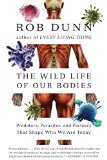Summary | Excerpt | Reviews | Beyond the Book | Read-Alikes | Genres & Themes | Author Bio

Predators, Parasites, and Partners That Shape Who We Are Today
by Rob DunnThis article relates to The Wild Life of Our Bodies
 In an article in The Daily Telegraph, Dr. Roy Sleator, a lecturer at Cork Institute of Technology in Ireland, states that, "We are, in essence, only 10 percent human. The rest is pure microbe." In a June 2011 report, National Public Radio's Science Desk Correspondent, Robert Krulwich, agrees. Yes, he says, our bodies do indeed consist of roughly ten times more microbial cells than human cells. And they are, for the most part, not just handy but essential to our existence. Especially the ones inside our intestinal tract.
In an article in The Daily Telegraph, Dr. Roy Sleator, a lecturer at Cork Institute of Technology in Ireland, states that, "We are, in essence, only 10 percent human. The rest is pure microbe." In a June 2011 report, National Public Radio's Science Desk Correspondent, Robert Krulwich, agrees. Yes, he says, our bodies do indeed consist of roughly ten times more microbial cells than human cells. And they are, for the most part, not just handy but essential to our existence. Especially the ones inside our intestinal tract.
Krulwich goes on to report the recent discovery that different people the world over have varying sets of intestinal microbes. These sets of microbes have been found to determine whether or not we are susceptible to certain diseases, even whether we are prone to obesity. It all begins the moment we are born. In utero we are microbe free, a tabula rasa upon which no germ has laid a "leg." However, as soon as we make our way into the world, whether via birth canal or Caesarian section, we begin to pick up the microscopic hitchhikers who will ride along with us throughout our remaining days. And that's a good thing. Because these passengers do indeed help protect us from evil bacteria.
More interesting still, are the findings of Peer Bork, Manimozhiyan Arumugam and Jeroen Raes from the European Molecular Biology Laboratory in Heidelberg, Germany. Bork says, "We found that the combination of microbes in the human intestine isn't random. Our gut flora can settle into three different types of community - three different ecosystems, if you like." Only three, whether we hail from Baghdad or Baltimore. Each with its own set of criteria governing what we can and can't tolerably eat and which diseases we are prone to.
Interestingly, "food, diet, [and] culture don't seem to matter. Nor do age, gender or nationality. So if we look at a bunch of Alaskans and a bunch of Indians, it now seems their gut bacteria will not look that different. What's more, all three 'gut types' will show up in both groups." Krulwich adds with great surprise, "The scientists don't know how to explain this finding. It's so startling."
"In gut bacteria, we are united," quips science writer Ed Yong.
If you're interested in "meeting the bacteria," click on this link to see a slideshow of computer enhanced artwork of the microbes within us.
Image above of salmonella bacteria
Filed under Medicine, Science and Tech
![]() This article relates to The Wild Life of Our Bodies.
It first ran in the August 4, 2011
issue of BookBrowse Recommends.
This article relates to The Wild Life of Our Bodies.
It first ran in the August 4, 2011
issue of BookBrowse Recommends.






Your guide toexceptional books
BookBrowse seeks out and recommends the best in contemporary fiction and nonfiction—books that not only engage and entertain but also deepen our understanding of ourselves and the world around us.